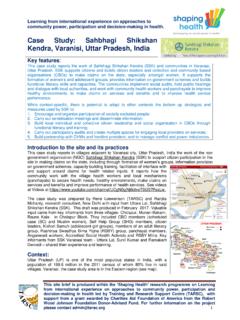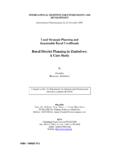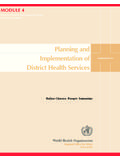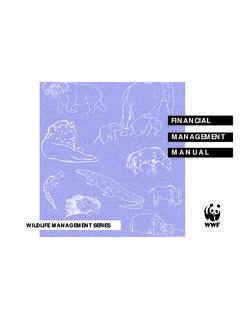Transcription of Assessment of facilitators and barriers to maternal …
1 Assessment of facilitators and barriers to maternal and child health services in four rural and urban districts of zimbabwe Report R Loewenson, A Kadungure, S Shamu Training and Research Support Centre (TARSC). With S Laver, W Mushayi UNICEF Collaborating Centre for Operational Research and Evaluation (CCORE). Harare, May 2012. Table of Contents Executive Summary .. 2. 1. Background .. 3. 2. Aims and objectives of the study .. 3. 3. Methods .. 4. 4. 7. Features of the population Health service Children's health and health care ..14. Women's health and health care ..19. Health service accessibility and cost ..23. Health service uptake and acceptability ..27. Community perceptions of barriers and facilitators to health service 5. 34. Characteristics of the Health needs and equity in coverage.
2 35. Availability and physical facilitators and barriers ..36. Accessibility and financial facilitators and barriers ..37. Acceptability and social facilitators and Perceived strategies and views on dealing with 6. 39. 7. 42. 8. Abbreviations .. 42. Appendix A Household questionnaire .. 43. Appendix B: Key informant interview guide .. 49. Cite as: Loewenson R, Kadungure A, Laver S, Shamu S, Mushayi W (2012) Assessment of facilitators and barriers to maternal and child health services in four rural and urban districts of zimbabwe TARSC, UNICEF CCORE Harare Design: R Loewenson, S Laver, A Kadungure, S Shamu, W Mushayi Field work: A Kadungure, S Macheka, K Ndlovu, P Mcijo, R Chikara, R Chasinda, T. Muchefa, T Mudyiwa, S Marima, T Zhoya, M Majaha, B Zikhali, Analysis: R Loewenson, A Kadungure, S Shamu Peer review.
3 D Dhlakama, S Laver, W Mushayi Report: R Loewenson, A Kadungure, S Shamu We acknowledge the permission of Ministry of Health and Child Welfare to implement this study and the peer review by Dr D Dhlakama of the protocol and draft report 1. Executive Summary This study aimed to assess the facilitators and barriers to access to maternal and child health services in women and in children under five years in zimbabwe . It was commissioned by UNICEF and implemented by TARSC with guidance and peer review from Ministry of Health and Child Welfare. Using a cross sectional study design, interviews were implemented with 1018 households with at least one woman who was pregnant in the last year and with a live child less than 5 years of age as well as 24 key informants from community, health workers, local government and NGOs personnel.
4 The widest gaps in health need were by residence (urban- rural ) and economic/ wealth status, including for poorest groups within urban areas. Geographical targeting and the lifting of user fees in part address economic differentials in health, but further measures are needed to support uptake, such as social communication and interaction with community health workers. The association between absence of safe sanitation and elevated risk of diarrhoeal disease points to the need to invest in improved sanitation. The use of public services for MCH was high across all wealth groups. Distance to services, availability of supplies and costs (transport and service) were the major barriers to service uptake and coverage, more for maternal health services than for child health services.
5 This calls both for fee barriers to be lifted and supplies and staffing to be funded. If supply side issues are not addressed, people incur high costs to travel to more distant services with supplies and staff, increasing catastrophic expenditure even after fees are lifted. The evidence suggests that the most critical measure is to bring the relevant staff and supplies needed for essential maternal and child health services to primary care level, to avoid the cost burdens and differentials in coverage that arise if people have to travel to reach services with supplies and staff. The service deficits identified at primary care level included vaccine supplies, contraceptives, midwives, waiting mother shelters and ambulances, with the latter two needed for referrals to district services.
6 As follow up, comprehensive audit and gap analysis against service standards (essential benefits) at primary care level can inform resource allocation, while supply chain / bottleneck analysis can identify the causes of these shortfalls and stock-outs at primary care level. Cost was a key barrier. The finding that poorer groups in both urban and rural areas spend a higher share of their income on maternal health services is highly inequitable. Lower income households find the costs of maternal health services unaffordable, with high levels of asset sales in the poorest groups that may be contributing to further impoverishment. There was a consistent view across all groups that all charges for consultation, diagnostics and medicines should be removed at primary care level (backed by improved supplies), with funding to ensure that this is also applied in urban councils.
7 There was less consistency in the views on charges at district level. The facilitators are the inverse of the barriers . In addition, community health cadres (VHWs, EHTs, CBDs) were found to support effective uptake, as do improved education and income in women and supportive family influence. These factors point to the need for measures that support women at both individual and social level, and that link women to community level actors and resources (community health workers, antenatal groups, early child education groups, waiting mother shelters) to support their decisions and actions on health. 2. 1. Background The 2009 Multiple Indicator Monitoring Survey (MIMS) (Zimstat and UNICEF2009) showed that infant and child mortality rates are higher in males, rural children, children of mothers with primary education and of households in the lowest wealth quintile, with larger differences by area and wealth.
8 Measles immunisation coverage in the 12-23 month age group shows a gradient of social differentials by area, education and wealth. There was a relatively even distribution of children sleeping under insecticide treated nets and treatment with antimalarials was higher in lowest income, rural communities. For treatment of children with Acute Respiratory Infection (ARI) at a health facility there were large differences across wealth groups and provinces. The reasons for these differences would need to be further assessed. A 2010 analysis found evidence of progress in 2010 in health outcomes, with significant reductions in HIV prevalence; improved child mortality and under-nutrition; better immunisation coverage; and some improvement in assisted deliveries (TARSC, MoHCW 2011).
9 However these gains were not shared by all, There was evidence of gaps and widening social differentials. While geographical inequalities dominated in child mortality up to 2005, socio-economic drivers became more significant after that. Child stunting showed wide differences across mothers with different social and economic conditions. There were wide wealth, education and provincial differentials in antenatal care coverage and assisted deliveries and social differentials in access to interventions for prevention and treatment of AIDS (TARSC, MoHCW 2011). The social differentials in maternal health begin with the unmet need for family planning and exist at all stages of the reproductive process. The unmet need for family planning is higher in adolescents and older women, for rural women with no education and in the lowest income quintile.
10 These social gradients apply across family planning, antenatal care and assisted delivery services. In combination women in the highest wealth quintiles have four times the delivery effectiveness in accessing these key elements of effective maternal health care (TARSC, MoHCW. 2011). It is important to explore further the barriers and facilitators that lead to social differences in the uptake of health services. Measuring that a population accesses and utilizes a service does not guarantee that it does so according to its real needs, nor that the population that did not use the services did not need to do so. Uptake may be affected by physical and financial access, including distance, travel time, waiting time, opportunity cost of time, affordability; user fees, transport costs; cultural acceptability, beliefs, religion, gender, type of facility, neighbourhood of facility, quality of patient interaction with the health system, across respect for persons, and service orientation.
















